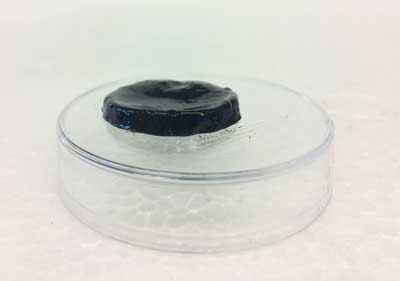| Nov 26, 2018 | |
A starch and graphene hydrogel geared towards electrodes for brain implants(Nanowerk News) The Materials + Technology research group at the UPV/EHU’s Faculty of Engineering – Gipuzkoa has, in collaboration with the University of Strasbourg, developed some hydrogels with potential biomedical applications (Carbohydrate Polymers, "Starch/graphene hydrogels via click chemistry with relevant electrical and antibacterial properties"). Starch was used as the raw material and a three-dimensional network structure was produced. When graphene and salvia extracts were added, the hydrogel was provided with electrical properties as well as the necessary antibacterial ones. |
|
 |
|
| Sample of the hydrogel developed. (Image: Kizkitza Gonzalez / UPV/EHU) | |
| Hydrogels are physical and chemical polymer networks capable of retaining large quantities of liquid in aqueous conditions without losing their dimensional stability. They are used in a whole host of applications and when various components are added to them, they acquire specific properties such as electrical conductivity. This was the path followed by the Materials + Technology research group in the Department of Chemical Engineering and Environment of the UPV/EHU’s Faculty of Engineering – Gipuzkoa, and for its hydrogel they selected a biopolymer that had not been used hitherto for applications of this type: starch. | |
| “One of our lines of research focuses on starch and we regard it as having biological, and physical and chemical properties suitable for producing hydrogels,” said Kizkitza Gonzalez-Munduate, a member of the group. | |
| When creating the hydrogel, they took its use in neural interfaces into consideration, in other words, the components responsible for the electrical connection in implants that interact with the nervous system. | |
| “Due to the fact that the traditional electrodes of neural interfaces made of platinum or gold, for example, are rigid, they require conductive polymer coatings to bring their flexibility closer to that of neural tissue. Right now, however, smaller devices are being called for and also ones that offer better mechanical, electrical and biological properties,” explained the researcher. | |
| The hydrogels developed “address these demands very well”, explained Gonzalez. To provide the hydrogel with electrical conductivity, they resorted to graphene, “a material of great interest. It provides electrical properties that are highly suited to the hydrogel, but this also has a drawback: it is not easily stabilised in water. We used extracts of salvia to overcome this obstacle and to render the graphene stable in an aqueous medium. These extracts also make the hydrogel even more suitable, if that is possible, for use in medicine as it also has antimicrobial and anti-inflammatory properties”, she added. | |
| Another of the distinctive features of this research was the use of so-called click chemistry to produce the hydrogel. “It is a strategy that in recent years has been grabbing the attention of the scientific community, because, unlike other means of synthesis, click chemistry does not tend to use catalysts in the reactions; in addition, no by-products are generated and they are high-performance reactions,” said the researcher Gonzalez. | |
| Although this product was designed for a very specific application, the researcher recognises that this product of bioengineering has a long way to go until it can be used in patients. “It was a piece of research at an initial level focussing on the engineering side relating to the material. Now, the various levels will have to be overcome and the corresponding tests designed”. | |
| The industrial chemical engineer Kizkitza Gonzalez-Munduate belongs to the Materials + Technology research group in the Department of Chemical Engineering and the Environment of the UPV/EHU’s Faculty of Engineering - Gipuzkoa. She is currently writing up her PhD thesis under the supervision of Dr Nagore Gabilondo and Dr Arantxa Eceiza. It was during a stay at the University of Strasbourg that the opportunity for the two universities to collaborate emerged, specifically with the BioTeam research group at the French university led by Dr Luc Avérous. |
| Source: University of the Basque Country | |
|
Subscribe to a free copy of one of our daily Nanowerk Newsletter Email Digests with a compilation of all of the day's news. |
